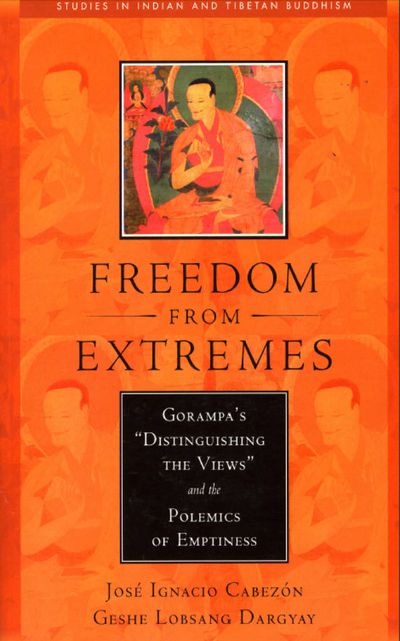- Preface by José Ignacio Cabezónvii
- In Memoriam: Geshe Lobsang Dargyay (1935-94) by Eva Neumaierxi
- Introduction1
- Distinguishing the Views of Emptiness: Moonlight to Illuminate the Main Points
of the Supreme Path- Thematic Subdivisions of the Text63
- Chapter 1: Three Ways of Understanding the Madhyamaka69
- Chapter 2: The Refutation of Dol po pa97
- Chapter 3: The Refutation of Tsong kha pa115
- Chapter 4: The Middle Way as Freedom from Extremes203
- Abbreviations239
- Notes243
- Bibliography337
- Index383
No edit summary |
No edit summary |
||
| Line 11: | Line 11: | ||
*{{i|In Memoriam: Geshe Lobsang Dargyay (1935-94) by Eva Neumaier|xi}} | *{{i|In Memoriam: Geshe Lobsang Dargyay (1935-94) by Eva Neumaier|xi}} | ||
*{{i|Introduction|1}} | *{{i|Introduction|1}} | ||
*Distinguishing the Views of Emptiness: Moonlight to Illuminate the Main Points of the Supreme Path | *Distinguishing the Views of Emptiness: Moonlight to Illuminate the Main Points<br>of the Supreme Path | ||
**{{i|Thematic Subdivisions of the Text|63}} | **{{i|Thematic Subdivisions of the Text|63}} | ||
**{{i|Chapter 1: Three Ways of Understanding the Madhyamaka|69}} | **{{i|Chapter 1: Three Ways of Understanding the Madhyamaka|69}} | ||
| Line 22: | Line 22: | ||
*{{i|Index|383}} | *{{i|Index|383}} | ||
|AddRelatedTab=No | |AddRelatedTab=No | ||
|StopPersonRedirects=No | |||
}} | }} | ||
Revision as of 14:56, 29 July 2020
What is emptiness? This question at the heart of Buddhist philosophy has preoccupied the greatest minds of India and Tibet for two millennia, producing hundreds of volumes. Distinguishing the Views, by the fifteenth-century Sakya scholar Gorampa Sonam Senge, is one of the most important of those works, esteemed for its conciseness, lucidity, and profundity. Freedom from Extremes presents Gorampa's elegant philosophical case on the matter of emptiness here in a masterful translation by Geshe Lobsang Dargyay.
Gorampa's text is polemical, and his targets are two of Tibet's greatest thinkers: Tsongkhapa, founder of the Gelug school, and Dolpopa, a founding figure of the Jonang school. Distinguishing the Views argues that Dolpopa has fallen into an eternalistic extreme, whereas Tsongkhapa has fallen into nihilism, and that only the mainstream Sakya view—what Gorampa calls "freedom from extremes"—represents the true middle way, the correct view of emptiness. Suppressed for years in Tibet, this seminal work today is widely regarded and is studied in some of Tibet's greatest academic institutions.
Gorampa's treatise has been translated and annotated here by two leading scholars of Tibetan Buddhist philosophy, and a critical edition of the Tibetan text on facing pages gives students and scholars direct access to Gorampa's own words. José Cabezón's extended introduction provides a thorough overview of Tibetan polemical literature and contextualizes the life and work of Gorampa both historically and intellectually. Freedom from Extremes will be indispensable for serious students of Madhyamaka thought. (Source: Wisdom Publications)
| Citation | Cabezón, José Ignacio, and Geshe Lobsang Dargyay, trans. Freedom From Extremes: Gorampa's "Distinguishing the Views" and the Polemics of Emptiness. Studies in Indian and Tibetan Buddhism. Boston: Wisdom Publications, 2007. |
|---|---|
- Gorampa (go rams pa bsod nams seng ge): lta ba'i shan 'byed theg mchog gnad kyi zla zer compiled from three different sources:
- The Complete Works of Go ram bsod nams seng ge (vol. 3) in Sa skya pa'i bka' 'bum: The Complete Works of the Great Masters of the Sa skya Sect of Tibetan Buddhism (vol. 13), compiled by bsod nams rgya mtsho (Tokyo: The Tõyö Bunko, 1968), 47 folios.
- lta ba'i shan 'byed theg mchog gnad kyi zla zer (Distinguishing the Views by Gorampa bsod nams seng ge), published together with rtags kyi rnam bzhag rigs lam gsal ba'i sgron me of mkhan chen bsod nams lhun grub (Sarnath: Sakya Students' Union, 1988—date of preface), pp. 1-154.
- An unidentified mechanical reproduction of a handwritten text in the collection of the library of the Institut für Kultur und Geschichte Indiens und Tibets, Hamburg (access number MIV 345/6, catalogued 1968?), most likely printed in Buxa Duar, India in the early 1960s, 42 folios.
- (Above sources not found), see also: Gorampa (go rams pa bsod nams seng ge): lta ba'i shan 'byed theg mchog gnad kyi zla zer. In gsung 'bum bsod nams seng+ge, Vol 5: 417-510. Dehra Dun: sakya college, 1979.

- (Above sources not found), see also: Gorampa (go rams pa bsod nams seng ge): lta ba'i shan 'byed theg mchog gnad kyi zla zer. In gsung 'bum bsod nams seng+ge, Vol 5: 417-510. Dehra Dun: sakya college, 1979.


